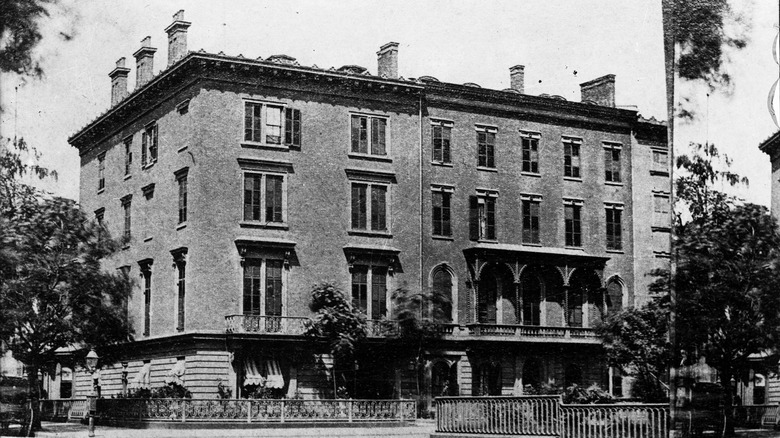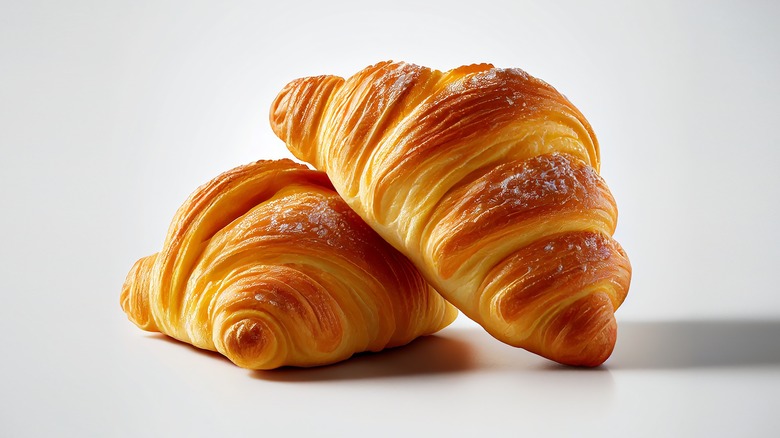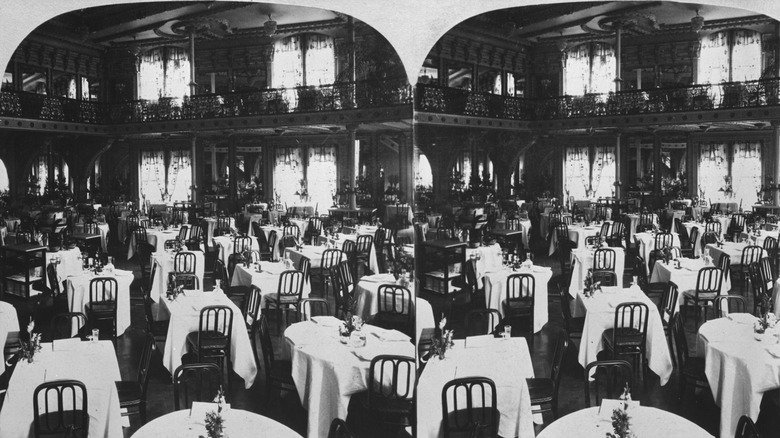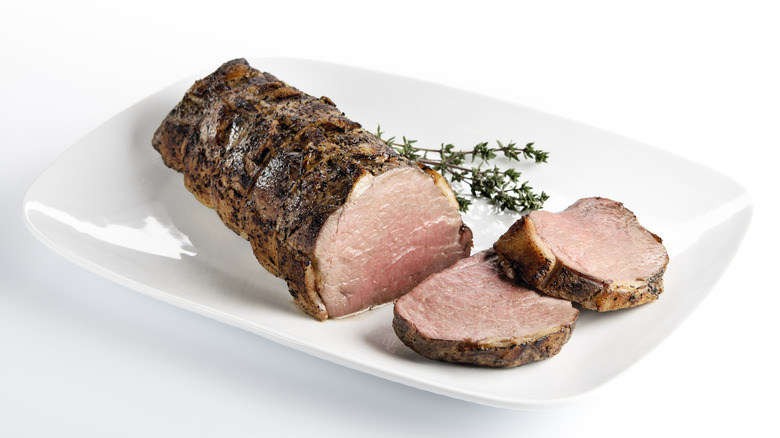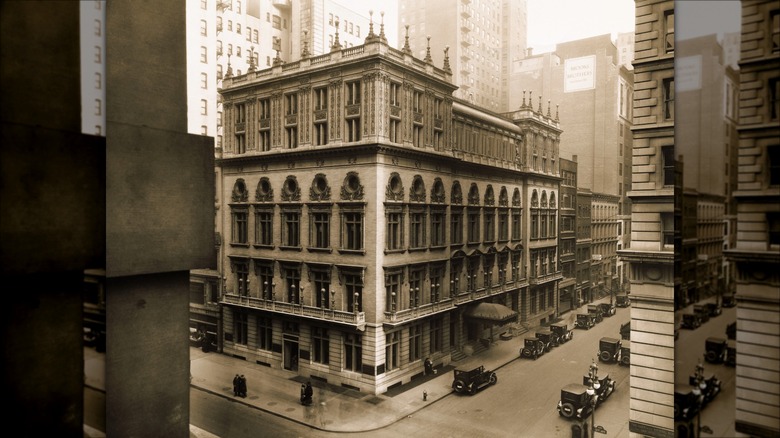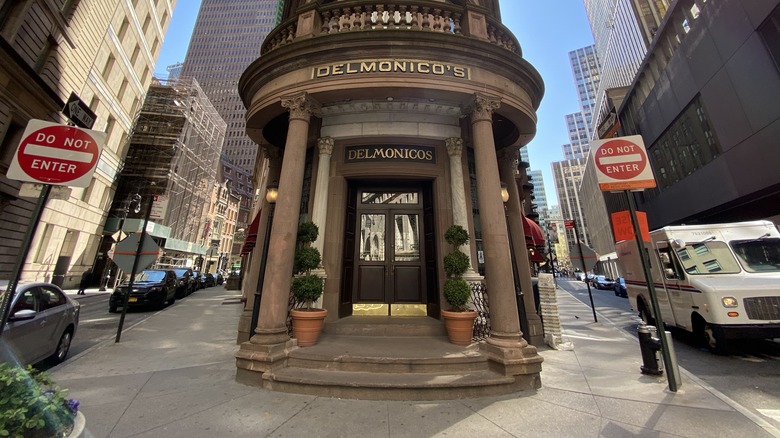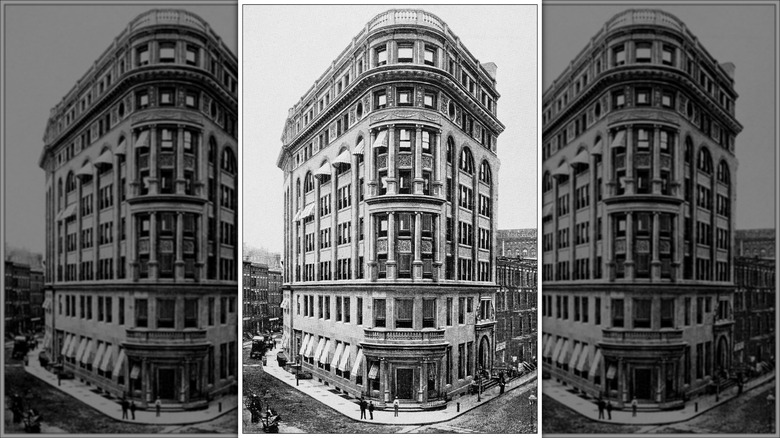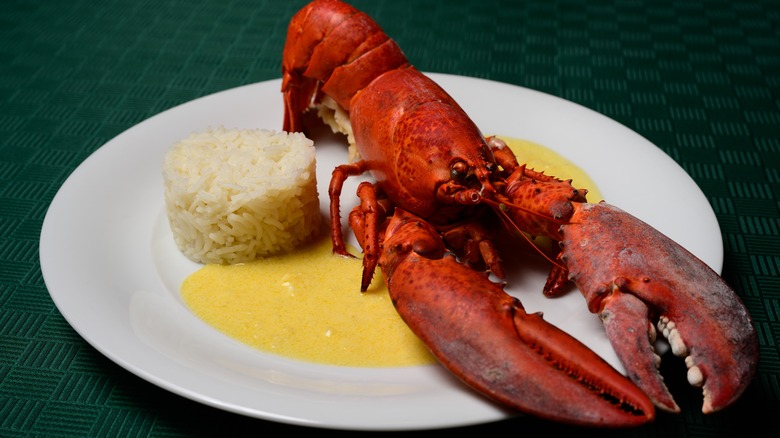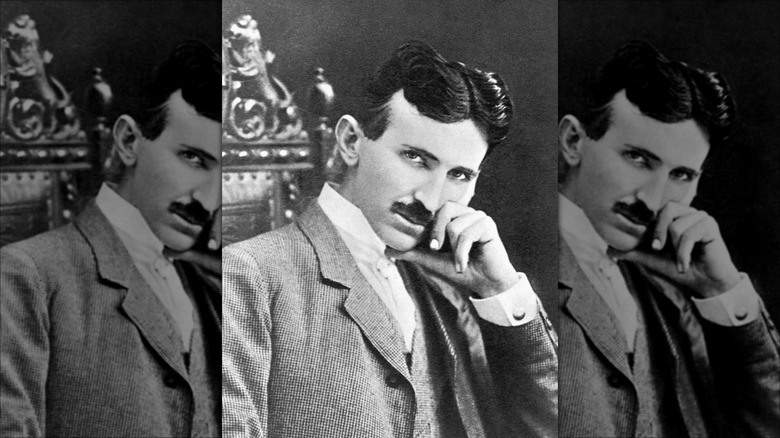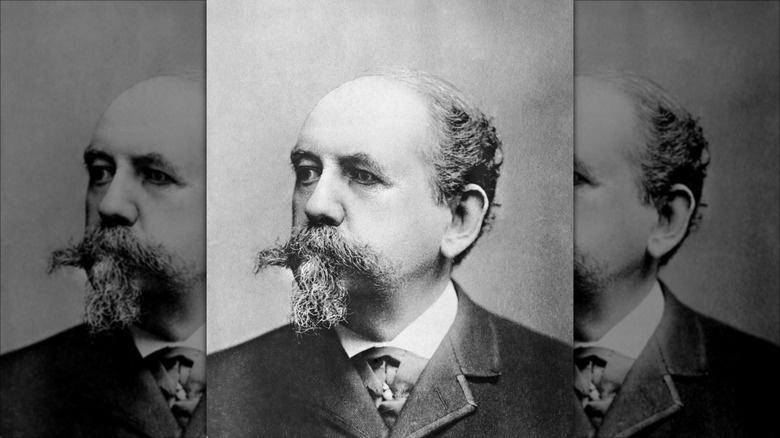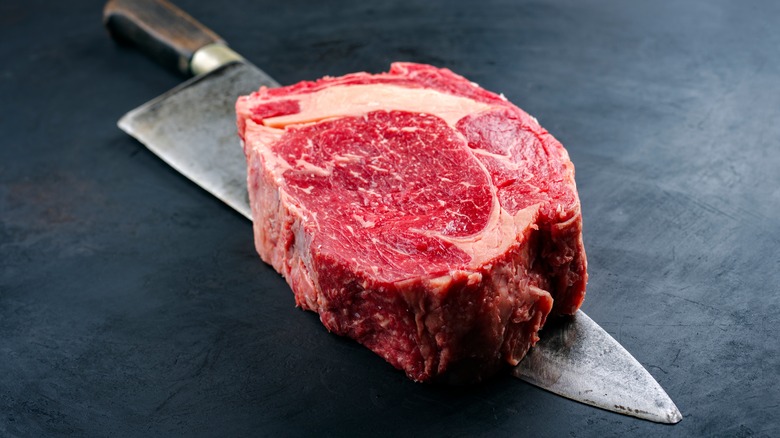What It Was Like To Eat At The First Steakhouse
Delmonico's, America's first steakhouse, was opened by two brothers, Giovanni and Pietro Delmonico, in New York during 1837. This restaurant offered a dining experience that was unlike anything else in the United States. The dining room was grand, the menu expansive, and the clientele exclusive. Eating at Delmonico's was a truly majestic experience that many steakhouse aficionados would love to experience today, quirks and oddities included. Thankfully, plenty of sources survive from this time, allowing us to paint a picture of what eating in America's first steakhouse was like.
The Delmonico brothers started their empire by opening a café in 1827 and went on to open numerous restaurants. While they always dreamed big, what they couldn't imagine was the enormous impact their restaurant would have on how those in the U.S. ate. In a few short years, their venture would become a byword for luxury and form the basis of a national industry that's set to reach $1 trillion in sales in 2024. More impressively, Delmonico's has survived to see its impact; after several short closures, the restaurant is open today and is still frequented by celebrities and steak enthusiasts alike.
Originally, Delmonico's served pastries
Before it became America's first restaurant and steakhouse, Delmonico's was a café come bottle shop. This strange combination stemmed from the two brothers' previous careers. Giovanni Delmonico was a merchant ship's captain and, during his voyages, gained a prestigious understanding of wine, while Pietro was a baker. Thanks to both of the brothers' efforts, Delmonico's gained a reputation for being well run, orderly, and clean. Soon after it opened in 1827, the café became a valued part of New York's nascent dining scene.
Delmonico's was not the United States' — or indeed New York's — first coffee-serving establishment. In fact, coffee houses such as the King's Arms were opened in New York during 1696, some 80 years before America gained independence. That being said, Delmonico's was unique thanks to the quality of its food and drinks, especially the pastries. These pastries were European in style and, due to Pietro's skills, soon became the talk of the city. In a short period, Delmonico's became so profitable that the brothers were able to entertain the idea of opening America's very first restaurant.
It was the first restaurant in New York to offer food à la carte
With the earnings from their café, the Delmonico brothers took over the adjoining store and opened a restaurant in 1831. This was America's first restaurant. As such, dining here was an entirely unique experience; the public had only ever experienced taverns and coffee houses. In these spaces, all patrons were crammed together at large tables and food was served family-style at a specific hour.
Prior to Delmonico's, most Americans ate a cold, packed lunch — usually sandwiches they'd prepared in the morning. However, the restaurant's location in New York's commercial district soon saw locals exchanging their sandwiches for sit down, hot lunches consisting of French classics. This marked the beginnings of America's obsession with French cuisine, an obsession that lasts to this day.
Aside from the grandness of the dining room, the restaurant's team of trained waiters, and the food itself, the most surprising aspect of Delmonico's was the menu. Up until this point, those in New York were used to having only a single option when eating out; most taverns served the one dish the owner decided to prepare that day. As a result, having the ability to order à la carte was a revelation that gave Delmonico's patrons an unprecedented control over their dining experience.
Early menus included some familiar foods
The earliest Delmonico's menu that survives is from 1838. This multipage document offers a rare insight into dishes offered by America's first steakhouse. Unsurprisingly, beef plays a central role with various types of boiled beef, beef steak, tenderloin, and tongue being listed. Other familiar items include fried chicken, lamb chops, and breaded veal cutlets. Of course, this early menu also lists some dishes that contemporary Americans regularly eschew, such as fried calf's brains and stewed hare.
In contrast to modern steakhouses, patrons did not choose from multiple cuts of meat. Instead, they ordered either the beef steak or tenderloin. If patrons ordered the former, the cut they got depended on what was available in the kitchen. As a result, customers' experiences of Delmonico's steak varied widely with some given succulent, tender cuts while others received those of a less desirable nature. It was only after the standardization of beef cuts, which occurred in the latter half of the 20th century, that diners could be sure of exactly what they were ordering.
It was the first restaurant reviewed by the New York Times
The New York Times' first restaurant review was published in 1859 and featured a round-up of the city's leading institutions, including Delmonico's. One of the unnamed reporter's first comments revolves around the steakhouse's reputation as a fine-dining destination. They note that such a reputation makes for intimidating dining; Delmonico's waiters were known to sneer if patrons asked for a low quality wine or did not order their dishes in the "correct" sequence. That being said, once patrons had ordered, they could expect the best service imaginable. The reporter notes that the serving of all food and drink was precise, stylish, and performed by an impressively well-presented team of waiters.
This review also provides some insight into the astounding prices Delmonico's was charging only 30 years after being founded. At this time, meals ranged in price from $5 a head without wine, to $50 a head including wine. If inflation is taken into account, these sums are approximately $188 and $1,881 respectively. Thankfully, such prices were warranted, as the food at Delmonico's was deemed to be superb.
The restaurant was an early proponent of the farm-to-table movement
Delmonico's was ahead of its time in more ways than one as former executive chef at Delmonico's Billy Oliva highlighted to Gothamist: "Delmonico's was the first restaurant to offer farm-to-table dining [and] the Delmonico brothers started the first farm-to-table concept. Not satisfied by the quality of produce they could get in the markets of NYC, they bought a 220-acre farm in Williamsburg, Brooklyn and sourced their own."
This meant those dining at Delmonico's had an unprecedented choice of incredible vegetables that were much fresher than those served elsewhere. This is demonstrated by the menu of 1838, which included the likes of artichokes, eggplant, salsify, and asparagus.
The most popular of all Delmonico's vegetable dishes spotlights the humble potato. Delmonico's potatoes, as the dish was known, was a simple dish of mashed potatoes covered in breadcrumbs and melted cheese. It was beloved by many patrons, most notably President Abraham Lincoln.
Eating at Delmonico's was a grand experience
The first Delmonico establishment was closed after it was destroyed in the 1835 Great Fire of New York. The brothers responded by opening an even grander restaurant in 1837. Located at the intersection between three streets – Beaver, William, and South William – this restaurant became known as The Citadel. Everything about Delmonico's flagship restaurant was impressive — even the entrance to the building. This was due to a pair of marble pillars that stood sentinel by the front door. Although it hasn't been proven, it's long been suggested that these pillars — which are still in use — were taken from the Ancient Roman city of Pompeii.
The restaurant contained three floors and even had private dining rooms, a novelty that the rich and privileged adored; most Americans at this time ate at vast tables in taverns, literally rubbing shoulders with a host of strangers. Other common practices that patrons thought uncivilized, such as the ringing of a gong to announce the serving of food, were abandoned in Delmonico's in favor of European etiquette. This made dining at Delmonico's a rare and impressive experience.
Eating at Delmonico's did not come cheap
As we've seen, dining at Delmonico's was an expensive business with patrons being charged over $1,750 when splashing out. Those wishing to hire out Delmonico's had to be prepared to spend even more. This was highlighted by a banquet held by Sir Samuel Morton Peto in 1865 at the steakhouse. During this event, various dishes were served, including salmon à la Rothschild, pigeon, and duck. This decadent feast supposedly cost Peto $20,000 — that's over $380,000 in today's money.
Patrons at Delmonico's rarely paid so much. However, this did not stop several customers from complaining of the steakhouse's high prices. According to American Heritage, poet William Makepeace Thackery was once recorded as saying: "Don't, don't give a dinner at Delmonico's. I did it yesterday and it is a sin to spend so much money on your belly." That being said, Charles Ranhofer, who was executive chef at Delmonico's from 1862 to 1896, noted that a table of six could dine for $12, around $300 in today's money.
It was probably of little comfort to Delmonico's patrons that a great deal of the restaurant's earnings were spent on running costs. In The New York Times' 1859 review, it's suggested that the restaurant located in Broadway demanded an annual rent of $10,000, over $375,000 today.
Many famous dishes were invented by chef Charles Ranhofer
Although Delmonico's was known for its steak, especially after its eponymous cut of beef was introduced to the menu in 1850, the restaurant is remembered as the birthplace of several other dishes. This is largely thanks to chef Charles Ranhofer who started working at Delmonico's in 1862.
Ranhofer was a French chef who had learnt his trade in Paris. After moving to the United States, he soon found himself working at Delmonico's where he gained a reputation as America's first superstar chef. Ranhofer's excellent cooking was one of the main reasons he attained such fame. Another was his willingness to create dishes that catered to the tastes and whims of his regular patrons. The chef's creations included the now famous chicken à la king and lobster Newburg. Some people even suggest Ranhofer created the popular dessert, baked Alaska.
Due to Ranhofer's creativity, patrons at Delmonico's were treated to a menu rich in innovation. This proved to be as great an allure as the promise of exceptional steaks. Indeed, Delmonico's was famed for its ability to serve hundreds of guests with distinctly elaborate dishes, making it the foremost establishment when one aimed to impress.
Several celebrities frequented Delmonico's
Given Delmonico's status as the first and grandest steakhouse in the United States, it is no surprise that many celebrities frequented the restaurant regularly. Those who dined at Delmonico's regularly were almost guaranteed a glimpse of stars every now and again. The faces they were likely to see included Nikola Tesla, who reporter Arthur Brisbane called: "the tallest, almost the thinnest and certainly the most serious man who goes to Delmonico's regularly," via PBS.
Other stars who enjoyed the steakhouse included writer Mark Twain, who hosted his 70th birthday party at the steakhouse in 1905, and Charles Dickens. Delmonico's almost singlehandedly changed Dickens' negative opinion of American dining. After enjoying a banquet at the steakhouse in 1868, Dickens even made a speech celebrating the meal, the manner in which it was served, and promising to add an appendix to his earlier, harsher reviews of American food.
On occasion, Delmonico's even catered for royalty. In 1860, the restaurant held an event for some 3,000 people, one of which was Albert Edwards, Prince of Wales. Famously, the evening began with part of the building's dance floor collapsing. All guests were escorted to the dining room where they enjoyed dishes including filet mignon, grouse, and chicken consommé.
It was the site of many exceptional balls
Each of the various Delmonico's locations that opened during the 19th century were enormous. When coupled with the steakhouse's formidable reputation, this made Delmonico's the ideal venue for the 19th century's most decadent balls. Chief amongst these were the so-called Patriarch Balls. These balls were organized by Ward McAllister in an attempt to matchmake the children of New York's most distinguished families. The balls often involved a nine course Delmonico's supper that was served on gold plates. One of the Patriarch Balls, held in 1882, featured exquisite dishes such as truffled turkey, foie gras pâté, and truffled capons.
Aside from hosting prestigious balls, Delmonico's also catered for them. Perhaps the most luxurious event the brand catered was Alva Vanderbilt's famous masquerade ball, held in 1883. Thrown at her new house on Fifth Avenue, the ball welcomed 1,200 guests, each in costume. Delmonico's served an impressive menu that included favorites of the day such as terrapin, fried oysters, and sandwiches. It's also reported that Vanderbilt spent $65,000 on Champagne, which is equivalent to $2 million today.
Patrons enjoyed the Delmonico steak
The Delmonico steak was added to Delmonico's menu in 1850 and quickly became a popular item. As was the norm at this time, diners ordering the Delmonico did not know what cut of meat they were getting; the chef simply cooked and served whatever they felt was best that night. The fact the steak became so popular despite this ambiguity indicates how much faith the patrons had in Delmonico's kitchen team.
The term "Delmonico steak" stuck and steaks carrying this name are still ordered across the United States today. Usually, Delmonico steaks are made from rib steaks. However, they can be made from nine different cuts of beef. The only universal feature of these variations is that they are at least 2 inches thick. The Delmonico steak served at Delmonico's, an impressive 18-ounce cut of boneless ribeye, is easily that thick. It is priced at $75 and is still deemed the restaurant's specialty.
